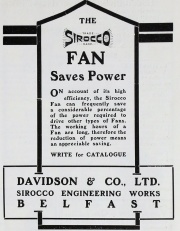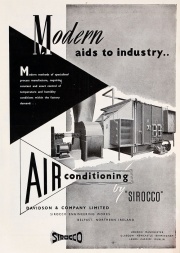Davidson and Co


























of Sirocco Works, Belfast.
of St. Nicholas Buildings, Newcastle-on-Tyne (1937).
Manufacturers of tea-drying machinery and the "Sirocco" fan.
1881 Company founded by Samuel Davidson in Belfast, developing machinery for processing tea.
1898 Private company.
1898 Samuel Davidson invented the forward-bladed centrifugal fan - the "Sirocco" fan.
1926 Davidson patented a mechanical dust collector.
1927 Received an order from the Durban Navigation Collieries of South Africa an order to supply one of the most power mine fans yet constructed. It is to be capable of dealing with 700,000 cubic feet of air per minute against a resistance of 7in. of water gauge, and it will require a steam engine of 1200 horse-power to drive it.[1]
1934 75" Aeroto fan to ventilate the section between Finsbury Park and Manor Park on the extension of the Piccadilly tube of the London Passenger Transport Board, from Finsbury Park to Cockfosters. Owing to the presence of tennis courts in the part of Finsbury Park under which the line runs, it was not possible to arrange for a ventilating shaft in the usual way, and it was necessary to run a horizontal duct for a sufficient distance to clear the tennis courts and then connect to a vertical ventilating shaft. The ventilating shaft terminated in an ornamental kiosk situated at a point close to the main line of the London and North Eastern Railway and at the north end of that company’s station. The installation of a centrifugal fan would have involved constructional and operating difficulties and it was decided to adopt the Aeroto axial-flow fan. It was specified to be capable of extracting 65,000 cu. ft. of air per minute through the shaft and tunnels against a pressure of 1.7 in. static water gauge. Under these conditions, the power absorbed was not to exceed 20 bhp. Driven by a 20 HP Metropolitan-Vickers motor, supplied at 440V, 33.33 Hz. The multi-blade rotor was a one-piece aluminium-silicon alloy casting, the correct blade profiles being obtained by grinding all over to templates. The blades were polished and the completed rotor balanced.[2]. The duty was queried by a correspondent, and a reply from a Director of Davidson's, Mr A. Binns responded, stating that 'Actually the specified conditions which we had to work to were as follows : that the volume to be handled was to be 65,000 cub. ft. of air per minute ; that the estimated resistance of the circuit during traffic hours was to be 1-in. static water gauge, and during non-traffic hours 0.875-in. water gauge. We were also advised that when two trains were approaching at speed along both running tunnels simultaneously the piston action of the trains would give a positive pressure of supply of the air to the fan of approximately 1.4-in. static water gauge, and the fan design would be such that with the resistance reduced to this negative value, the motor would not be overloaded. On the other hand, immediately the trains had passed there was a reversing effect caused by the partial vacuum created, which was equivalent to a negative pressure of 2.2-in. total water gauge, and the design of the fan had to be such that there was still a movement of air in a forward direction from the fan against this negative pressure of 2.2-in. water gauge. It will be seen from the curve of the fan performance that it fulfilled these conditions, just being able to maintain a positive flow against the maximum pressure, and actually having a declining horse-power as the resistance decreased. ....'[3]
1937 Fan manufacturers. "Aeroto" Screw-type Fans. "Sirocco" Centrifugal Fans [4]
1960 Public company[5]
1961 Engineers and iron founders, specialising in the manufacture of fans for all purposes, air conditioning, dust collecting and pneumatic conveyance plant, and tea estate machinery. 1,300 employees. [6]
1988 Acquired by James Howden and Co. Name changed to Howden Sirocco.
See Also
Sources of Information
- ↑ The Engineer 1927/02/04
- ↑ Engineering 1934/01/26
- ↑ [[Engineering 1934/03/02
- ↑ 1937 The Aeroplane Directory of the Aviation and Allied Industries
- ↑ The Times Apr. 4, 1960
- ↑ 1961 Dun and Bradstreet KBE
- History of James Howden [1]

